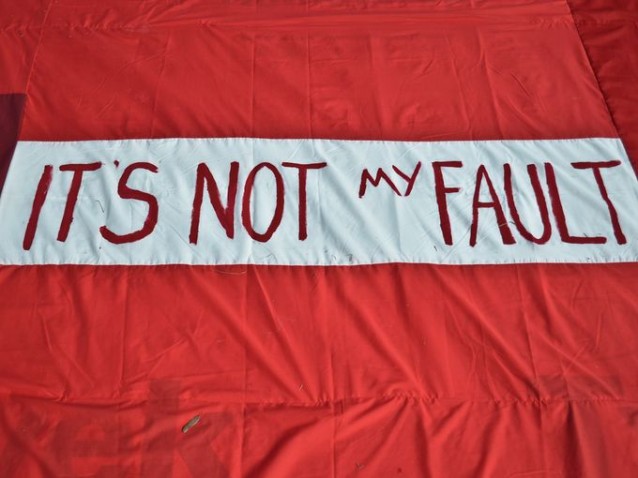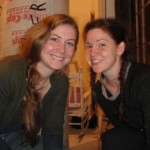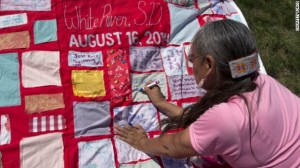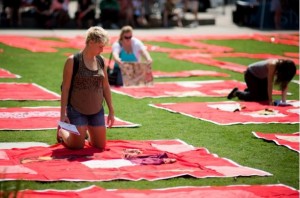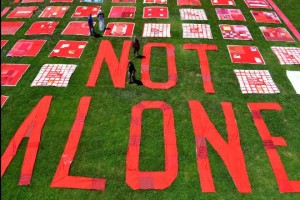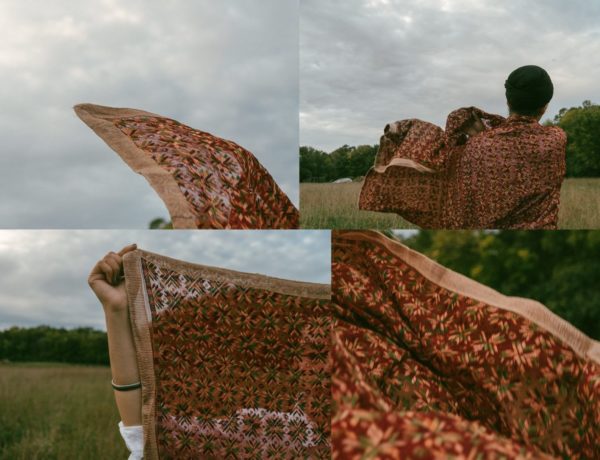Trigger warning: sexual abuse.
The 9/11 Memorial remembers those who lost their lives in 2001.
The Vietnam War Memorial respects those who fought in the Vietnam War.
The Statue of Liberty celebrates freedom.
But did you know there isn’t a monument honoring the millions of people who have survived a specific trauma? The trauma being sexual abuse and rape. There isn’t a monument in the United States honoring the survivors of sexual violence.
“Monuments serve as a public space where survivors can gather to heal, share stories, and be heard,” said Rebecca Nagle of FORCE: Upsetting Rape Culture. “We want a permanent monument where survivors can come together to re-connect with their community.”
It is this burning desire that inspired artist-duo Hannah Brancato and Rebecca Nagle, in 2010, to launch the group FORCE: Upsetting Rape Culture, a creative activist collaboration to upset the culture of rape and promote a culture of consent. In 2013, FORCE started the project The Monument Quilt to serve as a rallying cry for a permanent memorial in the United States for survivors of sexual violence.
“We don’t have any models or examples on what this would look like or how it would take shape, so we’re just building momentum right now,” said Rebecca.
“In the American community, but sadly, more so in the South Asian population and in Sikh families, the issue of rape and domestic violence is so taboo that it is swept under the rug,” said FORCE Development Consultant Amrita Kaur Dang. “That is the exact problem the Monument Quilt is trying to address.”
“The quilt strives to create a public healing space for survivors of sexual violence and to engage communities in supporting them rather than shaming them,” explained Amrita.
Currently, survivors of rape or sexual violence are marginalized and silenced by culture and institutions. Rebecca said, “In this day and age, it is safer to assault than it is to speak out against assault.”
According to Rebecca, rapists are not likely to face consequences for their actions, but those who speak out against their rapist will most likely feel backlash in the form of stigmatization, ostracisation, shaming, or an attack on his or her reputation.
“There are many cases that illustrate this,” said Amrita. For instance, in January 2012, Daisy Coleman, a Missouri teen, was shunned by her community after she spoke out against her rapist; her house was then set on fire.
“Just look at college campuses or the military. They don’t want to admit the have rapists in their community so they don’t convict the person. It’s a PR issue to them,” said Amrita.
FORCE believes that by discussing rape and sexual assault publicly and with communities, rape can be prevented. Rebecca expounded on this idea, “By removing the silence and the burden that’s placed on survivors, we’re encouraging the prosecution of rapists. As long as survivors are isolated, the status quo continues.”
“Social moments only happen when people come together in dialogue,” she added.
So why a quilt? How do pieces of fabric, stitched together help in healing and preventing rape?
When survivors participate in creating a quilt, many of them feel that a burden has been lifted. Participant Emily Sha from Chicago noted, “Working through art accesses a different part of your healing process that you can’t always reach through words alone.”
Dana Jim of the Cherokee-Navajo Nation pointed out the public impact the quilt can have. “The Monument Quilt brings into sharp focus the event of domestic violence to all who attend it. It manifests the cries. It also shows strength of survivors.”
Additionally, Rebecca said, “Creating a quilt organizes the community and brings them together, and the end result is a high profile display. It encourages public dialogue. It encourages to people to imagine what a country would look like when survivors come forward to a community that is equipped to support them.”
The quilt is also unique in that is crowd sourced. So far, FORCE has collected 300 survivor stories from 14 different US cities. The goal is to collected 6,000 stories by 2017 for a grand display on the National Mall in Washington D.C. Statistically, about 6,000 people are sexually abused in the US in one week. “The quilt will be up for one week,” said Rebecca, “To show that while we are celebrating the survival and strength of these 6,000 people, our country is in the process of creating 6,000 more. It’s an epidemic.”
“Another reason we chose a quilt was because of its historical connection to social justice movements, like the AIDS quilt or the underground railroad,” said Amrita. “Furthermore, the fact that a quilt is made up of smaller different pieces, we wanted the diversity of people who are affected by rape to be captured in our medium.”
Currently, beyond Amrita’s involvement, there are no other Sikh volunteers or leaders in the Monument Quilt project. “We want to change that,” said Amrita. “We are working with faith leaders to train them on how to create supportive spaces for survivors in their communities, and we want Sikhs to be a part of that.”
In Punjabi families, the idea of izzat (honor) is often invoked to silence survivors and thus, the perpetrators continue to abuse. “We want the Sikh community to be involved because this topic is so taboo. We want to break the silence around it.”
The beauty of the quilt is that anyone, anywhere can participate. “Quilt making workshops can happen in living rooms, gurdwaras, gurbani vichar circles, SSAs, pretty much anywhere. It’s a project for survivors but for allies too,” said Amrita.
Currently, the FORCE is creating training manuals and packets for different faiths so the topic and healing tools are relevant to their community. “There’s a Lutheran pastor here in Baltimore who has injected theology into rape-prevention and is excited to share it with other Lutheran churches.” FORCE recognizes that domestic violence topics are approached differently in each community and thus, they are adaptable in addressing those cultural needs. If you are interested in helping create Sikh-specific manuals with Gurbani based inspiration, feel free to contact Kaur Life or FORCE.
For Amrita, it is imperative for the Sikh community to be involved in this movement. “In Sikhi, one of the biggest tenets is that Sikhs are the defenders of the oppressed. Survivors of domestic violence are silenced, oppressed, and don’t have a platform. So, whether it’s helping those within our own community or survivors in the broader community, as Sikhs, we’re supposed to be standing up for them. It’s our duty and a seva.”
Next Quilt Display
The next Monument Quilt display in on Dec 8, 2014 in Jacksonville, FL where, Marissa Alexander is facing up to 60 years in prison for firing a warning shot against her husband who was beating her. FORCE has teamed up with the Free Marissa Now Campaign to highlight the unjust nature of the court ruling.
Getting Involved:
There are many was you can get involved!
Help make Sikh-specific training manuals.

